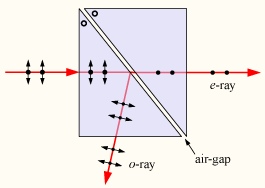.
Glan-Foucault prism

A Glan-Foucault prism deflects p-polarized light, transmitting the s-polarized component. The optical axis of the prism material is perpendicular to the plane of the diagram.
A Glan-Foucault prism (also called a Glan-air prism) is a type of prism which is used as a polarizer. It is similar in construction to a Glan-Thompson prism, except that two right-angled calcite prisms are spaced with an air-gap instead of cemented together. Total internal reflection of p-polarized light at the air gap means that only s-polarized light is transmitted straight through the prism.
Compared to the Glan-Thompson prism, the Glan-Foucault has a narrower acceptance angle over which it will work, but because it uses an air-gap rather than cement, much higher irradiances can be used without damage. The prism can thus be used with laser beams. The prism is also shorter (for a given usable aperture) than the Glan-Thompson design, and the deflection angle of the rejected beam can be made close to 90°, which is sometimes useful. Glan-Foucault prisms are not typically used as polarizing beamsplitters because while the transmitted beam is 100% polarized, the reflected beam is not.
The Glan-Taylor prism is very similar, except that the crystal axes and transmitted polarization direction are orthogonal to the Glan-Foucault design. This yields higher transmission, and better polarization of the reflected light. Glan-Foucault prisms are now rarely used, having been mostly replaced by Glan-Taylor polarizers and other more recent designs.
See also
* Glan-Taylor prism
Retrieved from "http://en.wikipedia.org/"
All text is available under the terms of the GNU Free Documentation License

